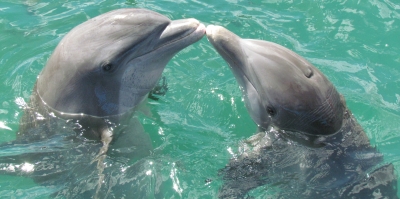
While friendly close contact is essential for these acquatic mammals social bonds, sharing space and air can also quickly spread disease.
Three young male dolphins simultaneously break the waters surface to breathe-first exhaling, then inhaling-before slipping back under the waves of the Chesapeake Bay in the U.S. “A perfect sync,” said Janet Mann, a dolphin researcher watching from a small skiff.
Synchronised breathing is something dolphins often do with close pals, such as these males, or that mothers and calves do together, said Mann. It’s a way of affirming the relationships that are so important to these highly intelligent and social mammals, like a handshake or a hug among humans. “It says, ‘We’re together,” said Mann, who is based at Georgetown University.
While such close contact is essential to dolphin social bonds, sharing space and air can also quickly spread disease. Mann and other scientists are trying to understand how a highly contagious and lethal disease called cetacean morbillivirus- related to measles in humans and first detected in Virginia and Maryland waters can spread rapidly among dolphins along the Atlantic Coast, as it did from 2013 to 2015.
Thousands of deaths
During that outbreak, more than 1,600 dolphins washed ashore on beaches from New York to Florida, according to the National Oceanic and Atmospheric Administration. Altogether, an estimated 20,000 dolphins died from the virus, and the region’s population of coastal dolphins shrank by about 50%.
“It’s much like COVID – it’s respiratory” in how it spreads, said Mann. “When dolphins breathe together at the surface, they’re sharing respiratory droplets just like we do when we’re talking or coughing on each other.”
She realised that the key to understanding swift virus transmission was tracing dolphin social networks, much as how public health authorities have tracked the COVID-19 pandemic.
To understand how diseases circulate in social animals such as humans, dolphins, or chimpanzees scientists must scrutinise not only the biology of a virus, but also how vulnerable populations interact, said Jacob Negrey, a researcher who studies animal viruses at Wake Forest School of Medicine. “Contact networks represent a double-edged sword,” he said. “Your friends that you need are also the individuals most likely to get you sick.”
Dolphins are extremely playful animals and often swim close together, sometimes even touching fins. “We call it holding hands,” said Mann.
“The males stay pretty coordinated with each other. The females sync, but not as regularly. They sync mostly with their offspring,” adds Mann. That difference in behaviour may help explain why males died in greater numbers during the most recent cetacean morbillivirus outbreak – a hypothesis the researchers are examining.
Depleted populations While Atlantic bottlenose dolphins are not endangered, NOAA considers their coastal populations to be “depleted”, meaning “below optimum sustainable population”.
Outbreaks of the virus emerge here every 25 years or so. And they strike dolphins and their close marine relatives elsewhere, including some endangered whale species.
University of Hawaii researcher Kristi West called the disease – which causes skin lesions, pneumonia, brain infections and a suppressed immune system – “the most significant threat to dolphins and whales on a worldwide scale”.
While viruses naturally occur in the wild, human disruption of marine habitats has made animals more vulnerable. “The disease becomes an even more significant threat when we combine it with other stressors that dolphins and whales throughout the world are facing,” said West. AP.
Picture Credit : Google




